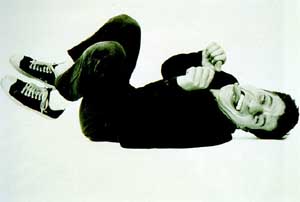

Milan based artist Maurizio Cattelan is the kind of guy who, as a boy, probably liked to look at the reflection in little girls patented leather Mary Jane's. The one who was able to fit a slingshot, a frog, dice, an army knife, crayons and several gum balls into a single pocket and had a devious plan for each of them. It is these kinds of playful, negligibly harmless traits that he brings to his adult conceptual art career. Cattelan's exhibition track record runs the gamut from creating a miniature diorama of a little squirrel, dead at his kitchen table with his tiny handgun on the floor beside him to the creation of a real soccer team composed of Senegalese workers living in Italy who competed on foozball tables and wore jerseys with their sponsors name Rauss! (a Nazi slogan meaning Get Out!). Believing that form should follow content, he creates work to suit the environment, considering all avenues of interpretation and weight regarding the exhibition space.
Cattelan's work could not be made in a vacuum, as it relies entirely on myths and metaphors of popular culture . He succeeds in entertaining as well as stupefying his audience by way of shocking us with appalling activities that border on the illegal. And why not? While as the initial ridiculousness grabs one's attention, there surely is more that can be read into his cockamamie schemes. His work seems to comment on the absurdity of the popular societal structures enforced by television, media and preconceived notions of right, wrong and upstanding morality. Proclaiming that if structure must exist why not mess with it a little, Cattelan's work is meant to ruffle feathers, to annoy as much as amuse.
In The Super Us, Cattelan asked his family and several friends to give his physical descriptions to a police sketch artist. Each description produced an illustration of Cattelan in that generic frontal mug shot style that can make anyone look like a criminal. Placed together, all the illustrations began to reveal distinctive features on one hand and gaping inadequacies on the other. Its in these inconsistencies that Cattelan's work rings of subtle awareness and commentary, while hiding behind the mask of the clown.
In another piece, titled Oblomov Foundation, Cattelan lists on an engraved glass plaque the names of one hundred patrons who gave him a grant totaling $10,000. The object itself functions only as a starting point for the narrative about the actual project; where the donors and plaque become merely red herrings for the intended use of the money. Cattelan actually gave his grant money to another young artist with only one stipulation, that the artist could not have any exhibitions for one year. Beyond functioning as a backhanded honor to that anonymous artist this piece winds up serving several purposes, least of which is furthering Cattelan's exhibition career while knocking out, or at least stunting the competition.
While Cattelan employs others in the production and realization of his work, it seems that the participant is placed into the role of straight man to Cattelan's prankster. Whether dressing a notoriously promiscuous gallery owner up in a penis/bunny suit or renting his exhibition space at the Venice Biennale to a perfume company for their billboard, it is apparent that there is more going on here than merely a light hearted prank. It is clear that he seeks subject matter that will subtly lay waste to these systems of societal norms; while having a hearty, conspiratorial laugh at the same time.
In
the case of Cattelan the well beaten, dead horse of challenging art rears
its ugly head once again and begs the question of what art can be. While
questioning the notion of the nature of art is a relatively old issue
in the art word, the validity of it as a question still holds water. Cattelan
work succeeds in bridging this gap between form and content, capturing
the attention of his audience and amusing them while still driving these
other issues home. Transcending the traditional values of art for beauty's
sake, Cattelan's artistic medium is limited only by the conception and
implementation of his current prank. Who's to say that the class clown
in fifth grade wasn't making art when they were sent to the principal's
office for misbehaving, they only had to
call it such.
Amy Stafford©1997